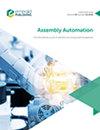基于变形梯度模型的非刚性装配变型分析
IF 1.7
4区 计算机科学
Q3 AUTOMATION & CONTROL SYSTEMS
引用次数: 2
摘要
目的本文旨在开发一种数学方法来分析非刚性组件的装配变化,考虑非刚性零件在装配过程中的制造变化和变形变化。设计/方法/方法首先,本文提出了一个变形梯度模型,该模型通过考虑非刚性零件的力和自重来表示装配过程中的变形变化。其次,将装配过程中开发的变形梯度模型集成到齐次变换矩阵中,以对变形的非刚性零件的变形变化和制造变化进行建模。最后,建立了一个分析装配变化传播的数学模型,以预测装配过程中由于制造变化和变形变化引起的尺寸和几何变化。通过对十字头非刚性装配的实例研究,结果表明,在装配过程中,非刚性零件的个体变形值较小。然而,所有非刚性零件的累积变形变化和制造变化的目标值(w)为−0.2837 mm,而目标值为−0.3995 当假定组件是刚性的时。目标值的差异表明,装配过程中非刚性零件变形变化对机械装配精度的影响不容忽视。独创性/价值本文提出了一个变形梯度模型来获得非刚性零件在装配过程中的变形变化。在现有工作中,通常使用有限元方法对小变形变化进行建模,使用所提出的变形梯度模型对其进行建模,并将其集成到标称尺寸中。使用变形梯度模型,可以计算非刚性零件的变形变化,并且可以容易地获得累积变形变化。通过将变形梯度模型集成到齐次变换矩阵中,开发了装配变化传播模型来预测非刚性装配的精度。本文章由计算机程序翻译,如有差异,请以英文原文为准。
Assembly variation analysis of the non-rigid assembly with a deformation gradient model
Purpose
This paper aims to develop a mathematical method to analyze the assembly variation of the non-rigid assembly, considering the manufacturing variations and the deformation variations of the non-rigid parts during the assembly process.
Design/methodology/approach
First, this paper proposes a deformation gradient model, which represents the deformation variations during the assembly process by considering the forces and the self-weight of the non-rigid parts. Second, the developed deformation gradient models from the assembly process are integrated into the homogenous transformation matrix to model the deformation variations and manufacturing variations of the deformed non-rigid part. Finally, a mathematical model to analyze the assembly variation propagation is developed to predict the dimensional and geometrical variations due to the manufacturing variations and the deformation variations during the assembly process.
Findings
Through the case study with a crosshead non-rigid assembly, the results indicate that during the assembly process, the individual deformation values of the non-rigid parts are small. However, the cumulative deformation variations of all the non-rigid parts and the manufacturing variations present a target value (w) of −0.2837 mm as compared to a target value of −0.3995 mm when the assembly is assumed to be rigid. The difference in the target values indicates that the influence of the non-rigid part deformation variations during the assembly process on the mechanical assembly accuracy cannot be ignored.
Originality/value
In this paper, a deformation gradient model is proposed to obtain the deformation variations of non-rigid parts during the assembly process. The small deformation variation, which is often modeled using a finite-element method in the existing works, is modeled using the proposed deformation gradient model and integrated into the nominal dimensions. Using the deformation gradient models, the non-rigid part deformation variations can be computed and the accumulated deformation variation can be easily obtained. The assembly variation propagation model is developed to predict the accuracy of the non-rigid assembly by integrating the deformation gradient models into the homogeneous transformation matrix.
求助全文
通过发布文献求助,成功后即可免费获取论文全文。
去求助
来源期刊

Assembly Automation
工程技术-工程:制造
CiteScore
4.30
自引率
14.30%
发文量
51
审稿时长
3.3 months
期刊介绍:
Assembly Automation publishes peer reviewed research articles, technology reviews and specially commissioned case studies. Each issue includes high quality content covering all aspects of assembly technology and automation, and reflecting the most interesting and strategically important research and development activities from around the world. Because of this, readers can stay at the very forefront of industry developments.
All research articles undergo rigorous double-blind peer review, and the journal’s policy of not publishing work that has only been tested in simulation means that only the very best and most practical research articles are included. This ensures that the material that is published has real relevance and value for commercial manufacturing and research organizations.
 求助内容:
求助内容: 应助结果提醒方式:
应助结果提醒方式:


